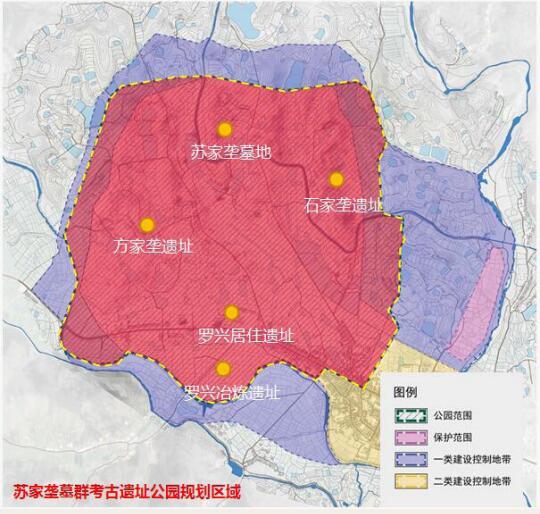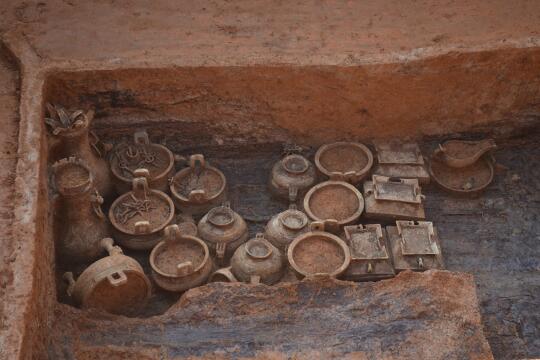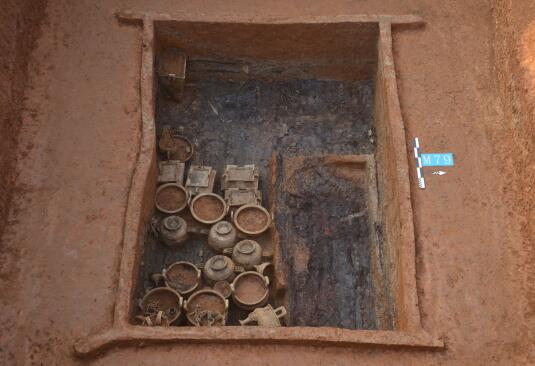Achievements of excavation of Sujialong site from Zhou Dynasty in Jingshan County, Hubei
From:Chinese Archaeology NetWriter:Date:2018-01-30
Sujialong site is located in Pingba Town, Jingshan County, Hubei Province. It’s a large city site of Zeng State consisting of cemeteries, architectural remains and copper smelting remains. From 2015 to 2017, excavation of southern hillock of the site was conducted jointly by Hubei Provincial Institute of Cultural Relics and Archaeology and School of Archaeology and Museology, Peking University and so on. A series of high-ranked burials, and copper smelting remains paralleling with burials from Zeng State during the Western and Eastern Zhou dynasties were discovered.
Distribution Map of Sujialong site

Cleared tombs at the south part of the cemetery
Archaeological Achievements
So far, 106 tombs and 2 horse-chariot pits were cleared. Relatively large tombs were arranged on ridge of hillock, while small tombs were distributed on both sides. From north to south, dates of tombs became later and later gradually. Almost no tombs broke one another, which suggested there was rather strict layout of the cemetery. Burials were well preserved. And more than 500 bronze ritual vessels had been discovered so far, all placed in order with clear assemblages. More than 50 bronze vessels have inscriptions, some of which are related to very important historical documents.

Tomb M79
Large-scale tombs M79 and M88 belong to “zengbo qi” (Marquis Qi of Zeng State曾伯桼) and his wife respectively. 8 ding-tripods, 4 li-pots with three feet, 1 yan-steaming cauldron, 4 gui-food containers with two or four handles, 4 fu-food containers, 2 hu-pots, 1 plate, 1 yi-water container were uncovered from M79. Among 8 ding-tripods, there are 5 sheng ding (containing boiled meat of sacrificial animal) and 3 ding-tripods with two handles on the rim. They are placed together with gui and fu vessels respectively. Several bronze vessels inscribed “zengbo qi曾伯桼” on them. 3 ding-tripods, 5 li-pots with three feet, 1 yan-steaming cauldron, 4 fu-food containers, 2 hu-pots, 1 plate and 1 yi- water container, as well as relatively many jade artifacts were found from M88. Noteworthy, there are important inscriptions such as “ke ti huaiyi (克逖淮夷, governing Huai and Yi regions)”, “gaifuren mi ke (陔夫人芈克, Mrs. Gai named MiKe)” on fu-vessels.

Tomb M79
According to results of archaeological survey and prospecting in the periphery, this area is predicted to be a large site with Sujialong cemetery as main part and simultaneous house remains and copper smelting remains, covering 2310,000 square meters. Inside the area, slag heaps were distributed more than 300,000 square meters. Based on test results and preliminary study, copper slag were mainly slag of local copper ore. So far, there were 3 copper smelting furnaces being found. On the remains of furnaces, pottery shards in paralleling time could be uncovered, and copper ingots were found around the remains of furnaces.

Tomb M88
Academia Significance
Important discoveries, including large settlement and large copper smelting remains paralleling with the cemetery, and abundant significant bronze ritual vessels with inscriptions from the cemetery as well, will provide vital previous materials for research on strategies of central government of Zhou Dynasty on the south and their mineral resources. The inscriptions convey sufficient information, according to which we can preliminarily predict that the famous bronze ware 曾伯簠(Fu-food container of Marquis in Zeng State)and the unearthed bronze assemblages belonged to Marquis Qi of Zeng State that correspond to each other. Inscriptions such as “ke ti huaiyi (克逖淮夷)” delivering same information with those on other bronze vessels from Zeng State found before, once again conform a fact that Zeng State had controlled Huai and Yi regions (lands located to the east of ancient China) at that time.

Inscription on bronze ware Hu-pot which means“zengbo qi” (Marquis Qi of Zeng State)
As rather early archaeological evidence found so far, inscriptions “gaifuren mi ke (陔夫人芈克)” on a fu-food container reveal relationship between Zeng State and early Chu State. Bronze vessels uncovered from the cemetery were placed in order and clear assemblage, which will make outstanding contribution to discussion on system of ritual vessels during West and East Zhou Peroid. These discoveries, together with that of the Yejiashan cemetery, Guojiamiao cemetery, Wenfengta cemetery, Leigudun cemetery and so on, have supplemented abundant materials of Zeng State which is indefinite in the historical documents, proving it to be one of the principalities in Zhou Dynasty having clearest material cultures and showing social complexity of Zeng State as well. (Translator: Ma Huanhuan Photo: Archaeology Press IA CASS)

